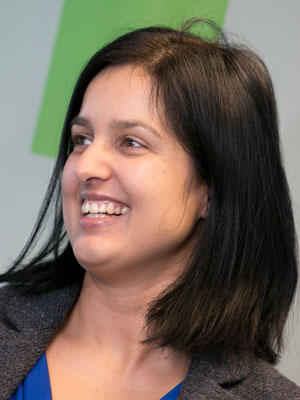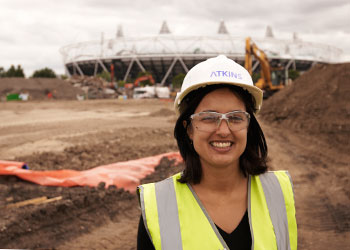Saphina Sharif is the business planning manager for Atkins’ design & engineering division who started her career at Atkins 14 years ago as a civil engineering graduate, and has spent a significant proportion of this working on construction sites and within client teams. Saphina has been a key person in the delivery of a number of infrastructure projects, including acting as Deputy Project Manager for the £500 million London 2012 Olympics enabling works project. After taking an extended maternity leave break to be with her two daughters, now aged three and four, Saphina returned to work in 2013 on a flexible working contract and since returning she has been appointed as a business planning manager covering business change projects and sales management, as well as external consultancy work.

“…by doubling the current percentage of women in engineering we would add 96,000 people into the talent pool. It would be naïve to just focus on only half the population to meet our resource needs…”
Civil engineers – raising the bar on delivering sustainable urban regeneration
I first learnt about engineering as a subject when I participated in the Engineering Education Scheme at school. I knew then that I wanted to pursue a career in civil engineering – the more I looked into it the more I realised the influence engineers can have in raising the bar on delivering sustainable urban regeneration, and I didn’t even realise that it was something girls didn’t really study until I went to university!
Since graduating I have held a number of project management and site supervision roles, including deputy project manager on the London 2012 enabling works project. Whilst I really loved being in a project delivery role, when I returned from maternity leave I took an opportunity to move into a business strategy and planning role, but who knows what shape the future might take – I fully expect to be at the front end delivering major projects again!
Britain’s Got Talented Female Engineers

Atkins encourages and showcases its female talent, with a number of our female engineers speaking at industry events, winning awards and accolades as well as being profiled in the press. Atkins also has a number of female STEM Ambassadors who bring engineering to life into school classrooms and running social media campaigns such as #notjustforboys – just a few of the ways in which we hope to challenge perceptions and attract more females into the engineering industry.
The Returners programme at Atkins
The Returners programme piloted earlier this year specifically targets women who are currently on maternity leave and preparing to return to work or have resumed their role within the last six months. It also covers those on adoption leave, and fathers who have made use of the shared parental leave allowances, although the course groupings are not mixed.
It is a two-day programme developed and given by an external company – Skills4 – conducted over a two month window, commencing just before or shortly after the person has returned to work. The course aims to deliver renewed confidence as well as practical tools and targeted interventions to help the returner focus on specific areas of work and home life, thus enabling them to safe-guard their professional, personal and mental wellbeing.
This programme is additional to the hugely popular Women’s Professional Development Programme (also developed by Skills4) which has been running since 2011 and is designed for women wishing to advance their career within Atkins.
Men in Atkins championing opportunities for women

We have senior male representatives at our Gender Balance Focus Group and throughout the organisation both men and women are championing opportunities for women – from female-focused STEM events to promoting Atkins’ flexible-working policies to implementing learnings from the unconscious bias awareness training.
Why diversity is so important in engineering and why this makes good business sense too
Diversity is so important in engineering as it can be detrimental to our business if we don’t mirror the demographics of our clients or understand how to work differently with people “different” to ourselves; our projects help create the built environment so it is essential we reflect and understand the real world we work in, thus our workforce should be representative of society and provide the thought, skills and team dynamic which comes with this: diverse teams are essential for creating high performance.
Skills deficit
Moreover there is a skills deficit – recent research by EngineeringUK advised that there will be an expected 2.56 million job openings in engineering companies up to 2022 alone! Atkins published the Skills Deficit Report earlier this year to look at the consequences a skills shortage could have on the delivery of real projects in the government’s National Infrastructure Plan.
Based on contributions from 40 experts, some of the significant consequences cited include delays in delivery of key infrastructure projects and stifling of innovation due to lack of resources. The report also highlighted that by doubling the current percentage of women in engineering we would add 96,000 people into the talent pool. It would be naïve to just focus on only half the population to meet our resource needs.
Breaking down barriers for women – if we don’t, who will?
It is so important for the Women’s Engineering Society, Atkins and other organisations to help break down barriers for women because if we don’t, who will?! Attracting more women to the industry is a fundamental part of addressing the skills deficit and achieving a diverse, creative and higher performing workforce – it needs each and every one of us to do “our bit”, to promote the industry to schoolgirls and boys alike, and to showcase our female role models to inspire the next generation.
Having to juggle work and home commitments is difficult, but organisations like Atkins must lead by example and knowledge-share so that we are constantly improving best practice.
http://angles.atkinsglobal.com/
https://twitter.com/atkinscareersuk
https://www.facebook.com/AtkinsGlobalCareers





